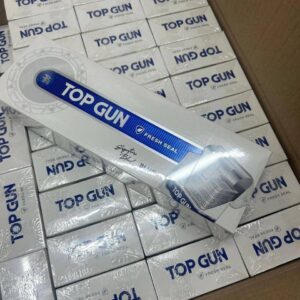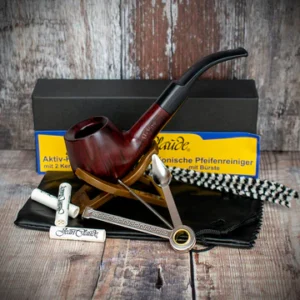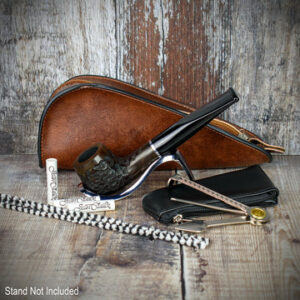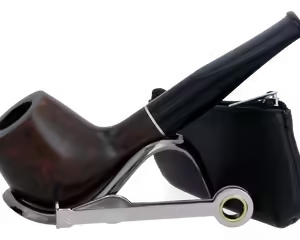PIPE STARTER KITS
Pipe Starter Kits
Introduction
Are you looking to begin your pipe-smoking journey the right way? A pipe starter kit sets the stage for success. With the right tools, you’ll avoid common mistakes, enjoy smoother draws, and extend your pipe’s lifespan. Below, you’ll find why a pipe starter kit is indispensable, what components to expect, how to choose one, and how to care for your setup.
By the end of this description, you should feel confident in selecting a kit, know how to use it effectively, and be informed enough to come back to this page when someone asks, “What’s in a good pipe starter kit?”
Why You Need a Pipe Starter Kit
Starting with just a pipe and tobacco can lead to frustration. Without the correct tools, problems arise:
-
Improper packing techniques (too loose, too tight)
-
Difficulty lighting (uneven burn, cherry that dies)
-
Trouble cleaning or maintaining the pipe
-
Shorter pipe life due to buildup or misuse
A pipe starter kit mitigates these issues by bundling the essential accessories. In one package, you get everything required to pack, light, maintain, and enjoy your pipe from day one.
Moreover, for beginners, having the full set encourages best practices. Rather than hunting for parts piece by piece, you can be ready immediately.
Finally, from an SEO perspective, many pipe enthusiasts search terms like “pipe starter kits,” “beginner pipe kit,” or “pipe smoking starter set.” By aligning your content (and product page) tightly with “pipe starter kits,” you increase the chance of ranking for that term — especially if your page offers rich, thorough content that users value.
What Does a Typical Pipe Starter Kit Include?
Although exact contents vary by brand, a well‑designed pipe starter kit often includes the following items:
-
Pipe – A quality briar, meerschaum, or cob pipe (or sometimes a small travel pipe)
-
Pipe tamper – To gently press and tamp the tobacco
-
Pipe cleaner brushes – Straight and bristled, for clearing residue
-
Reaming tool / pipe reamer – To remove cake buildup
-
Soft-bristle brush / cotton swabs – For finer cleaning
-
Pipe tool / multi-tool – Combination pick, shovel, and tamper
-
Lighter or matches – Specialized pipe lighters or wind‑resistant long matches
-
Pipe pouch or case – For safe transport and storage
-
Funnel / loading aid – For easier stuffing of tobacco (optional)
-
Instruction card / booklet – Tips on packing, lighting, and cleaning
Each component plays a role: the tamper helps maintain an even burn, cleaners prevent clogging, and reamers preserve bowl integrity. Without them, you might struggle with burnt tongues, clogged stems, or ruined briar.
Benefits & Key Features
1. All-in-One Convenience
You don’t need to hunt for individual accessories — everything arrives together.
Thus, you save time, avoid mismatches, and have a cohesive kit.
2. Better Smoking Experience for Beginners
With the right tools, even first-time users can learn proper techniques because the kit supports good habits from the start.
3. Cost Efficiency
Buying a kit often costs less than buying each component separately. Additionally, you avoid purchasing inferior or incompatible tools.
4. Longevity of Your Pipe
Proper maintenance tools (cleaners, reamers) ensure your pipe remains healthy and functional for years.
5. Portability & Storage
Many kits come with a pouch or case, allowing you to carry everything safely when traveling.
6. Guidance & Learning
An instruction booklet or guide helps new users understand how to use each tool properly, reducing trial-and-error.
How to Choose the Right Pipe Starter Kit
Choosing a kit requires attention to specific criteria. Below are factors you should consider:
Material & Quality
Choose accessories made from durable, corrosion-resistant materials (stainless steel, brass, quality woods). A cheap, flimsy tamper or cleaner can break and frustrate you.
Pipe Type
Decide whether you want a briar, cob, or travel pipe. Many beginners like corncob or briar pipes because they’re forgiving and affordable.
Completeness of Kit
Ensure the kit includes all essential items (tampers, cleaners, reamers). Some kits cut out parts to keep cost low — but that may limit your experience.
Case / Pouch
If you plan to travel with the kit, a sturdy case or pouch is vital to protect delicate parts.
Brand / Reputation
Select kits from reputable suppliers or pipe shops that specialize in smoking accessories. Read reviews to confirm durability and usability.
Price vs Value
Don’t choose simply the cheapest. A higher-quality kit may last far longer, giving better long-term value.
User Reviews & Ratings
See what other beginners or experienced pipe smokers say. Their feedback often reveals hidden strengths or flaws.
Warranty or Return Policy
A seller offering returns or warranty shows confidence in their product. That may give you peace of mind.
Sample Kit Walkthrough
Here’s an example of how a pipe starter kit gets used by a beginner:
-
Unpacking
You unpack the pipe, tamper, cleaners, reamer, tool, and pouch. You examine the booklet, which explains care steps. -
First Time Pack & Light
You gently fill the bowl loosely at first, tamp lightly, then add more and tamp again. You use the lighter or matches to light evenly. The tamper ensures an even surface. -
Smoking & Relighting
As the smoke continues, you occasionally tamp or relight if the cherry dies. The kit’s lighter or matches were designed for pipe use, so you can do this cleanly. -
Cleaning After the Smoke
Once done, you let the pipe cool a bit, then insert a pipe cleaner through the stem and bit, twisting to capture residue. You use the brush to clean deeper. -
Deep Maintenance
Periodically, you use the reamer to gently remove excess cake buildup (but carefully so you don’t damage the bowl). The tool helps remove blockages or explore inside the stem.
Over time, your pipe stays in good condition, and your smoking becomes smoother and more consistent.
-
Add alt text for images like “pipe starter kit contents on table,” “pipe cleaning tool in action,” “assembled pipe kit set.”
-
Use internal links to related pages (e.g. “pipe maintenance guide,” “best briar pipes for beginners”) to keep users on your site longer.
-
Add a FAQ section at the bottom (frequently asked questions) — this both helps conversion and gives you a chance to include additional keywords or long-tail queries.
-
Optimize metadata: title tag (e.g. “Best Pipe Starter Kits for Beginners | YourBrand”), meta description (a compelling 150‑160 character snippet including “pipe starter kits”).
-
Encourage user reviews and allow them to upload images — user-generated content boosts trust and SEO.
Detailed Component Descriptions & Tips
Below I dive deeper into each element you’ll find in a strong pipe starter kit, with tips on use, care, and common pitfalls.
The Pipe
-
Material: Most starter kits include a briar pipe (resistant to heat, absorbs moisture) or a cob pipe (lighter, cheaper).
-
Design: A classic bent or straight pipe; bowl shape should allow even burn.
-
Care tip: After smoking, empty ash gently. Never bang a hot pipe — always let it cool before cleaning.
Tamper
-
Purpose: To gently press down the tobacco so the cherry remains lit and the airflow stays even.
-
Good design: One end for tamping, one pick end for clearing blockages.
-
Tip: Tamp lightly — too much force may crush your draw.
Pipe Cleaners & Brushes
-
Types: Straight, bristled, flexible cleaners; small brushes for deeper cleaning.
-
Use: Run through the stem and shank while warm (but not hot).
-
Tip: Use multiple passes until the cleaner comes out clean. Don’t force — slow, gentle twists work best.
Reaming Tool
-
Role: Over time, a layer of carbon (cake) builds in the bowl. A little cake is good; too much restricts the bowl’s shape.
-
Caution: Only ream when cooled and gently. Overzealous reaming can damage the inner walls.
-
Tip: Ream only about 80% of the buildup — leave a thin protective layer (1 mm or so).
Pipe Tool / Multi-tool
-
Combines pick, shovel, tamper — versatile for opening blocked holes, clearing dottle, stirring tobacco.
-
Pick end helps dislodge wads or obstructions; shovel can help scoop residue.
-
Keep it clean — use soft bristle to remove lingering debris.
Lighter / Matches
-
Preferred style: Pipe lighters or soft-flame butane lighters that won’t scorch the rim.
-
If matches are included, long-stem matches reduce risk of burning your fingers.
-
Tip: Apply light to the edges first in a circular motion, then center.
Case / Pouch
-
Material: Leather, canvas, or padded synthetic.
-
Protects your investment during travel.
-
Compartments for each tool prevent scratches and tangling.
Loading Aid / Funnel
-
Helps align tobacco into the bowl without spilling.
-
Particularly useful for smaller bowl sizes or when you’re in tight spaces.
Instructional Guide
-
Covers reading packing, lighting, cleaning, and maintenance steps.
-
Especially helpful if you’re unfamiliar with pipe jargon (e.g. “cherry,” “draw resistance,” etc.).
Best Practices & Usage Tips
To ensure a satisfying experience and extend the life of your pipe starter kit, follow these best practices:
-
Start with small loads — don’t overpack. Leave airflow for an even burn.
-
Smoke slowly — aggressive puffing overheats the wood and creates sour flavors.
-
Tamp periodically — gently push down ash to maintain a stable burn.
-
Relight carefully — use circular lighting motion, avoid scorch.
-
Cool before cleaning — let the pipe rest for a few minutes.
-
Clean after each smoke — run a pipe cleaner right away to prevent residue hardening.
-
Deep clean weekly or biweekly — use brushes, reamers to prevent buildup.
-
Rotate pipes — if you have more than one, allow pipes to rest (24–48 hours) before reuse.
-
Store properly — in pouch or rest on pipe rack upright to allow moisture to escape.
-
Avoid harsh solvents — use isopropyl or specialized cleaners carefully, and let it dry fully.
Potential Use Cases & Audience
A pipe starter kit is ideal for:
-
New pipe smokers who don’t have tools yet.
-
Gift-givers seeking a thoughtful, high-end present.
-
Travelers who want a compact kit for on-the-go use.
-
Hobbyists who want to keep spare or backup tools.
-
Pipe clubs, collectible shops, and curated gift boxes.
Because the kit appeals to both novices and hobbyists, your product page can address both audiences: reassure beginners, yet emphasize quality and longevity for more experienced smokers.
Comparing Kits: What to Watch Out For
When comparing different pipe starter kits (yours vs competitors), watch for:
| Feature | Common Cheap Kit Weakness | What a Good Kit Offers |
|---|---|---|
| Thin, flimsy tools | Tools bend or break | Hardened steel or quality metals |
| Missing items | No reamer, no pouch, cheap lighter | All core parts included |
| Poor case | Flimsy bag, no padding | Structured case with compartments |
| No guide | Buyer unsure how to use tools | Well-written manual or video link |
| Weak lighter | Fuel leaks or short life | Refillable butane pipe lighter |
| Poor reviews | Customers complain of breakage | Solid ratings and testimonial photos |
By highlighting how your kit overcomes these common issues, you differentiate yourself.
Sample Product Description (Condensed Version)
Here’s a shorter version you might use in your listing:
The Ultimate Pipe Starter Kit includes everything a beginner needs to enjoy smooth, hassle‑free pipe smoking: a quality briar pipe, tamper, cleaning brushes, reamer, multi-tool, pipe lighter, and protective pouch. With clear instructions and durable tools, this kit ensures you pack, light, and maintain your pipe properly from day one. Ideal for gifting or first-time smokers who want a complete, reliable set.
You can expand each bullet with features, materials, and benefits further down on the page.
FAQ (Frequently Asked Questions)
Q: Is a kit necessary, or can I buy parts separately?
A: You could purchase items separately, but kits offer cost savings, guaranteed compatibility, and convenience. For a beginner, a kit is the safer, easier route.
Q: What type of pipe is best for beginners in a starter kit?
A: Many kits include briar or corncob pipes. Briar is durable and widely respected; corncob pipes are inexpensive and forgiving. Choose based on your budget and preference.
Q: How often should I clean or ream my pipe?
A: Use a pipe cleaner after every smoke. Deep cleaning (brush + reaming) can be done every 1–2 weeks depending on usage. Don’t over-ream — leave a thin carbon layer.
Q: What kind of lighter should I use?
A: A soft-flame or pipe-specific butane lighter is ideal. Avoid torch lighters which may burn the rim. The included lighter in your kit is usually safe and optimized.
Q: Can I travel with a pipe starter kit?
A: Yes — choose kits with sturdy pouches or cases that protect tools from damage or loss.
Q: Is there a warranty on the tools?
A: Many quality kits offer warranties or return policies. Be sure to check your supplier’s policy.
Q: Does the skill matter?
A: Yes — technique makes a big difference. Use your instruction guide, go slow, tamp lightly, and clean regularly. Over time, you’ll learn best practices and avoid common pitfalls.
Summary & Call to Action
In summary, a pipe starter kit is your gateway to a smoother, more enjoyable pipe-smoking experience. Begin with confidence, avoid damaging mistakes, and maintain your equipment properly — all thanks to having the right tools from the start.
If you order today, you’ll receive a complete kit (pipe, tamper, cleaners, reamer, lighter, multi-tool, and pouch) with step-by-step instructions. Start your pipe-smoking journey with confidence — get your pipe starter kit now.
Showing all 4 results




